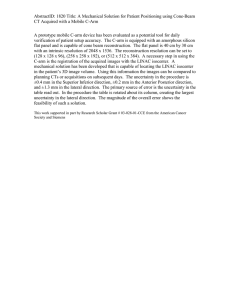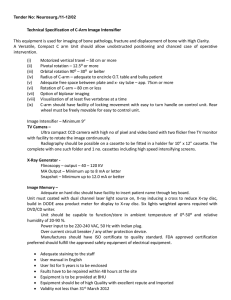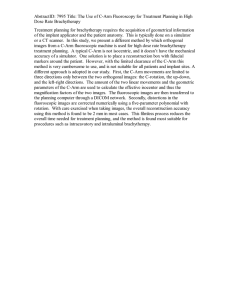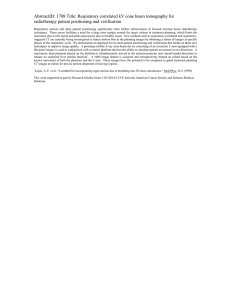RIN #14 RADIATION PROTECTION DURING ORTHOPAEDIC
advertisement
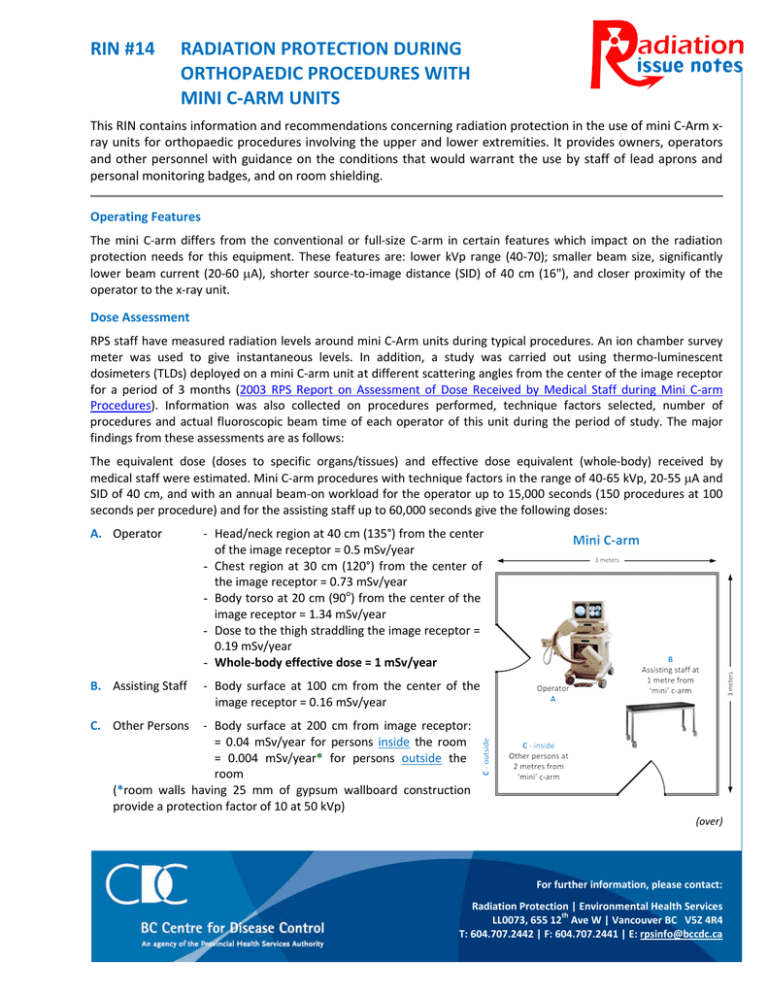
RIN #14 RADIATION PROTECTION DURING ORTHOPAEDIC PROCEDURES WITH MINI C-ARM UNITS This RIN contains information and recommendations concerning radiation protection in the use of mini C-Arm xray units for orthopaedic procedures involving the upper and lower extremities. It provides owners, operators and other personnel with guidance on the conditions that would warrant the use by staff of lead aprons and personal monitoring badges, and on room shielding. Operating Features The mini C-arm differs from the conventional or full-size C-arm in certain features which impact on the radiation protection needs for this equipment. These features are: lower kVp range (40-70); smaller beam size, significantly lower beam current (20-60 µA), shorter source-to-image distance (SID) of 40 cm (16"), and closer proximity of the operator to the x-ray unit. Dose Assessment RPS staff have measured radiation levels around mini C-Arm units during typical procedures. An ion chamber survey meter was used to give instantaneous levels. In addition, a study was carried out using thermo-luminescent dosimeters (TLDs) deployed on a mini C-arm unit at different scattering angles from the center of the image receptor for a period of 3 months (2003 RPS Report on Assessment of Dose Received by Medical Staff during Mini C-arm Procedures). Information was also collected on procedures performed, technique factors selected, number of procedures and actual fluoroscopic beam time of each operator of this unit during the period of study. The major findings from these assessments are as follows: The equivalent dose (doses to specific organs/tissues) and effective dose equivalent (whole-body) received by medical staff were estimated. Mini C-arm procedures with technique factors in the range of 40-65 kVp, 20-55 µA and SID of 40 cm, and with an annual beam-on workload for the operator up to 15,000 seconds (150 procedures at 100 seconds per procedure) and for the assisting staff up to 60,000 seconds give the following doses: A. Operator - Head/neck region at 40 cm (135°) from the center of the image receptor = 0.5 mSv/year - Chest region at 30 cm (120°) from the center of the image receptor = 0.73 mSv/year - Body torso at 20 cm (90o) from the center of the image receptor = 1.34 mSv/year - Dose to the thigh straddling the image receptor = 0.19 mSv/year - Whole-body effective dose = 1 mSv/year B. Assisting Staff - Body surface at 100 cm from the center of the image receptor = 0.16 mSv/year C. Other Persons - Body surface at 200 cm from image receptor: = 0.04 mSv/year for persons inside the room = 0.004 mSv/year* for persons outside the room (*room walls having 25 mm of gypsum wallboard construction provide a protection factor of 10 at 50 kVp) (over) For further information, please contact: Radiation Protection | Environmental Health Services th LL0073, 655 12 Ave W | Vancouver BC V5Z 4R4 T: 604.707.2442 | F: 604.707.2441 | E: rpsinfo@bccdc.ca RIN #14 RADIATION PROTECTION DURING ORTHOPAEDIC PROCEDURES WITH MINI C-ARM UNITS Conclusion Whole-body doses received by operators will not exceed 1 mSv/year provided their individual annual beam-on workload does not exceed 15,000 seconds (e.g. 150 procedures up to 100 s or 300 procedures up to 50 s) with typical technique factors at 40-65 kVp, 20-55µA and SID of 40 cm. The doses received by assisting staff and other persons during mini C-arm procedures will not exceed 1 mSv/year provided their distance from the unit is routinely about 1 meter away or farther, even with beam-on workloads as high as 400,000 seconds per year. Recommendations 1. Operators, whose only x-ray exposure is from mini C-arm procedures, do not require personal monitoring devices or lead aprons, when their individual annual workload does not exceed 15,000 seconds of actual fluoroscopic time. Where it is difficult to keep track of the operator’s workload, it is recommended that operators use personal monitoring devices and lead aprons in view of their proximity to the mini C-arm. Assisting staff and other persons inside the room do not require personal monitoring or protective apparel if they routinely position themselves at 1 meter or farther from the image receptor. 2. Operators should ensure their hands stay out of the useful x-ray beam during use. 3. For other persons located outside the room, no additional protection is required (i.e. no additional shielding in the walls needed). 4. Staff whose duties include assisting with other x-ray procedures that require the use of personal monitoring devices are advised to wear their monitors in the mini C-arm room. 5. Monitoring of secondary radiation around newly installed mini C-Arm equipment should be considered for an initial period of three (3) months, using TLDs (thermo-luminescent dosimeters) to confirm that the doses are not above expected levels. 6. If the operator’s annual beam-on workload exceeds 15,000 seconds with technique factors much higher than 65 kVp and 55 µA, further evaluation is required.
